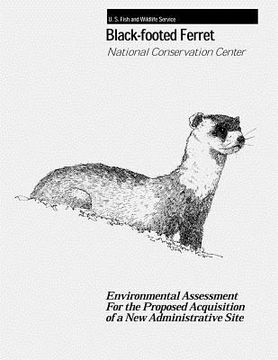Black-Footed Ferret - National Conservation Center: Environmental Assessment For the Proposed Acquisition of a New Administrative Site (en Inglés)
Reseña del libro "Black-Footed Ferret - National Conservation Center: Environmental Assessment For the Proposed Acquisition of a New Administrative Site (en Inglés)"
The black-footed ferret is a small, nocturnal carnivore closely related to minks, weasels, and badgers. Originally, the black-footed ferret ranged from the Canadian plains to the intermountain west and perhaps as far south as Mexico, but today it is the most endangered mammal in the United States (USFWS 1988). As early as 1967, populations had been reduced to the point where the species was officially recognized as endangered. A major cause for the decline in black-footed ferrets is thought to be the 90-98 percent reduction of the range of prairie dogs. Black-footed ferrets cannot survive outside of prairie dog towns, relying almost exclusively on prairie dogs for food and use of their burrows for shelter. Despite protection under the Endangered Species Act when it was enacted in 1973, by 1979, the last known ferrets had died and the species was declared extinct (USFWS 1988). In 1981, a population of black-footed ferrets was discovered near Meeteetse, Wyoming, and the study and recovery of the species began again. Unfortunately, by 1985 canine distemper and sylvatic plague had a severe combined effect on the Meeteetse population and the remaining 18 ferrets of this population were brought into captivity (USFWS 1988). In 1987, a captive breeding program was initiated at the Wyoming Game and Fish Department's Sybille Wildlife Research Center near Wheatland, Wyoming in cooperation with the U.S. Fish and Wildlife Service. A year later, the Service revised and published a recovery plan for the black-footed ferret. The American Zoo and Aquarium Association also initiated a Species Survival Plan (SSP) and ferrets were sent to several zoos to create additional breeding populations. The SSP is considered the essential core of the endangered ferret population. Today, over 50 percent of the captive-bred SSP black-footed ferrets come from the Sybille facility, which was renamed the National Black-Footed Ferret Conservation Center (FCC) after the Service assumed responsibility for managing the site in 1996. Several zoo breeding programs continue to contribute to the ferret population, as well as field breeding projects started in 1996. As of July 1999, through reintroductions in Montana, South Dakota, and Arizona, the number of ferrets in the wild (200) is larger than the last wild population at Meeteetse, Wyoming (130) (M. Lockhart, pers. comm.). This success is due in part to advances in breeding and preconditioning techniques which have increased survival rates of released ferrets. Continued development of these techniques, and expansion of the FCC to accommodate greater outdoor breeding and preconditioning, is critical to the black-footed ferret recovery program. The Service proposes to purchase a 40-acre parcel to be used as a new administrative site for the National Black-footed Ferret Conservation Center. The Ferret Conservation Center (FCC) is currently located at the Wyoming Game and Fish Department's Sybille Wildlife Research Center near Wheatland, Wyoming. The new site is located in Larimer County, Colorado. The 40-acre parcel is part of the Meadow Springs Ranch, a 25,680-acre parcel owned by the City of Fort Collins. Following the purchase of this property, the Service would construct several buildings for staff, maintenance, breeding, quarantine, and administration as well as 50-100 outdoor pens for breeding and preconditioning of ferrets. An access road approximately one-half mile in length also would be constructed to the site. The construction of the facility would be conducted in phases as funding becomes available. The purpose of the proposed action is to expand both the number and quality of ferrets produced in captivity. Since over half of the world's captive black-footed ferrets are at the FCC, these changes must occur primarily at this facility. The proposed new site for the FCC also will increase public access and awareness of the black-footed ferret and other endangered species recovery programs.

